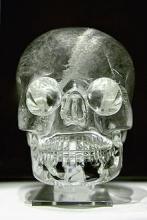In the late 19th century, replicas of human skulls carved from quartz crystal were being sold as pre-Columbian artifacts. They varied in size from beads to larger than life size. Some were crude and some were very well executed. Most of the publicity has been about a few excellent life size crystal carving. The collection of a Parisian antiquity dealer named Eugene Boban contained 3 crystal skulls. His collection was sold to Alphonse Pinart who donated the collection to the Trocadero Museum.
Many crystal skulls are at claimed to be of Aztec or Mayan origin prior to the arrival of Columbus. There are paranormal claims associated with these skulls. Some people have claimed that some of these skulls can produce miracles such as causing visions, curing cancer, killing people and causing premonitions of coming events. Recently, a claim has been made that if thirteen special crystal skulls can be reunited, a great disaster associated with the end of a Mayan calendar cycle in 2012 can be prevented. Many tests have been performed on crystal skulls but no evidence of any extraordinary properties have ever been found.
Although there are many carvings of human skulls in pre-Columbian Mesoamerican art, none of the crystal skulls are from documented excavations. Several crystal skulls in the British Museum were carefully examined in 1967, 1996 and 2004. The indented lines marking the teeth were carved by 19th Century rotary jewelry tools. The type of crystal used to make the skulls is only found in Madagascar and Brazil. The conclusion of the study was that those particular skulls were probably carved in the German town of Idar-Oberstein which was well know for carving things from Brazilian quartz. While this does not prove that all the crystal skulls are fakes, they probably are.
